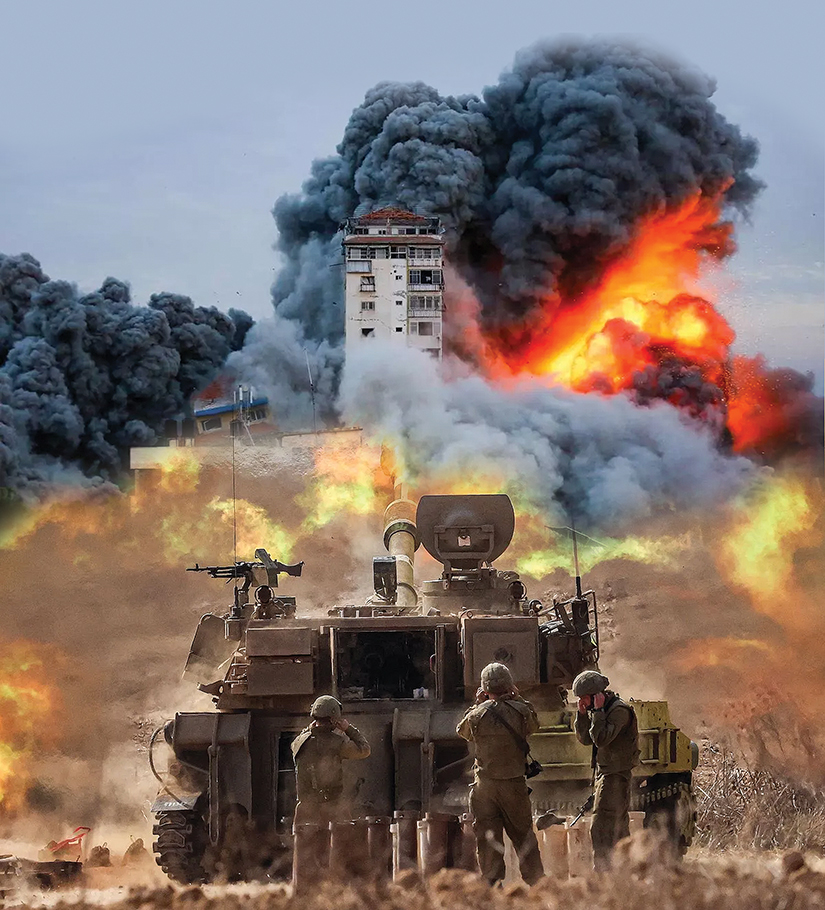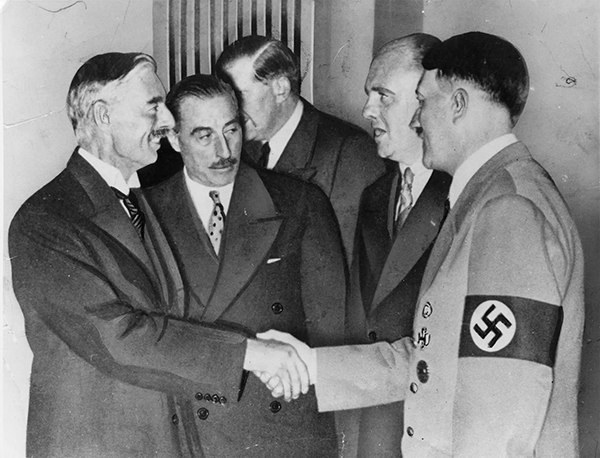
The Israel-Hamas conflict
A Bhagavad-gita perspective
By Chaitanya Carana Dasa
Social media and mainstream media are now filled with images of thousands of missiles being sent by Hamas, which is the Palestinian extremist group in the Gaza strip attacking Israel and various cities. From the Bhagavad-gita’s perspective, how do we see this terrible conflict in which thousands of people have been killed, an uncountable number of people have been taken hostages, and conflict seems to be on the verge of escalating?
I will address the Gita perspective from three different points: the three N’s. The first N is the ‘nature’ of the violence; the second is the ‘necessity’ for confrontational approaches, and the last is the ‘need’ for approaches beyond the confrontational.

While violence is an unfortunate and unavoidable part of life in this world, at the same time, the Bhagavad-gita is very careful in ensuring that violence is used within limits. The kshatriyas are a specially trained class of people who are meant to protect others from harm and to use force if required for that purpose, and they are meant to protect others from hurt and never attack civilians.
That’s why the Kurukshetra war was fought at a particular designated venue, namely Kurukshetra, where civilians were neither targeted nor killed. But the terrorist violence that we are seeing in these current attacks, where missiles are launched indiscriminately, including largely on civilian targets and territories, is the antithesis of kshatriya violence, where unarmed, unprepared, and unsuspecting civilians alone are targeted for the purpose of creating fear and intimidation and terror. So, such violence against civilians needs to be condemned in the strongest possible terms.
Necessity of confrontational approaches
The second point is the necessity of confrontational approaches at times. While we all would like that conflicts be minimized or avoided or resolved by peaceful means, the reality is that sometimes some people are so maddened by their hunger for power, by their memories of

grievance and their cravings for vengeance, or by their extreme ideologies, that they essentially become wicked. Then there is no talking sense with them. In fact, trying to have a peaceful negotiation with such elements ends up essentially appeasing them, and appeasing people who are wicked only empowers and emboldens them to do far worse things in the future. That’s how, in one way, the Second World War escalated with Neville Chamberlain, the British Premier, appeasing Hitler repeatedly while his expansionist aggression engulfed much of Europe. Appeasement will not work with extremist elements, and the need for confrontational approaches to weed out such elements has to be acknowledged. This, in fact, was the purpose of kshatriyas. The Bhagavad-gita (18.42) states that when such approaches are required, kshatriyas as the warrior class do not flinch from violence; they are ready to fight where it is required.
Need for solutions beyond the confrontation
While confrontation is required for those who are power-hungry or maddened for war for whatever reason, most people from any demographic are not that power-hungry or mad. Most people simply want to go ahead with their lives, and that’s why it’s vital that no community be lumped together in any particular negative way.
This particular Middle East conflict can be seen solely in religious terms: one religion attacking another and another religion trying to defend itself. And yes, the religious dimension is important in this conflict. But humans are complex beings, and though religious ideologies might motivate some people towards extremism, it is not the sole motivator for most people. Such complexity is evident in the signing of the Abraham Accords which would have seemed impossible just a few years ago. Yet Israel has been able to have some arrangement for peaceful relations with the UAE and other Islamic countries in the Middle East. Thus, factors other than solely religious can guide decisions, and that’s where the Bhagavad-gita’s analysis of human nature into the three modes — sattva, rajas, and tamas — is helpful.
The mode of tamas is associated with complaining, violence, and destruction. The mode of rajas is associated with craving and fighting, or doing whatever is required to fulfil the craving. And the mode of sattva is associated with clarifying, trying to understand. So, the solution will not come simply by thinking that we will eradicate the enemy and thus we alone will reign. Once we go on the path of eradicating those whom we oppose or those who oppose us, where is it going to stop? Because there will always be someone or the other who opposes us, even in the group that we consider presently as “us” in the war against “them.” That’s why while those who are extremists, those who are influenced or controlled by the mode of ignorance, need to be neutralized, still the vast majority is not that destructive or vindictive. Especially those who are in sattva, those who are with somewhat risen consciousness, if they are empowered, then they can come together and find a solution at some level of meaning.
Pertinently, the Bhagavad-gita (8.15) states this world is a place of distress, duhkhalaya. What this statement means is that there will never be any perfect solutions. No one will have a world in which they have no enemies. What, then, can we do? Even if we can’t have perfect solutions, we can at least have trade-offs — if not the most tolerable trade-offs, then at least the least intolerable trade-offs. With hard-eyed realism, if people in sattva from both sides come together and have discussions — of course after the extremist elements have been purged — then the non-confrontational approaches can also help us to come towards some level of peace. This is where the Bhagavad-gita’s wisdom offers humanity in general and thoughtful leaders in particular resources for raising human consciousness.
If while pursuing violent means to curb extremists simultaneously, non-confrontational methods are pursued to eventually establish a more workable peace, then that is the way to go beyond the recurrence of such horrifying confrontations that are happening. Our prayers for the souls of all those who have unfortunately lost their lives and our prayers for strength to all those who have survived such losses. We hope that higher consciousness manifests and peace prevails soon.
World War III: A Bhagavad-gita Perspective
As the conflict between Israel and Hamas is prolonging and threatening to expand, let us try to look at the horrifying prospect of an impending war from Bhagavad-gita’s perspective. I’ll talk about three things: sparks, slogans, and soberness.
Sparks
Small sparks can lead to huge fires that can burn down entire forests, entire cities. When World War I happened, it started with just one prince, not even very influential, being assassinated. That led to a chain of events which cascaded into a global war, the likes of which were unknown in recent historical memory. When the British politicians sent their soldiers to war, they expected that those soldiers would return in some ten days. They didn’t come back for five years, and many of them never came back.
Alluding to such catastrophes, the Bhagavad-gita states that inside and outside us can be the perfect storm. The mind inside us is like a raging wind — vayor iva su-dushkaram (6.34). If it gets filled with anger, vengeance, revenge, then it can trigger a stormy set of emotions from within. And outside, certain stimuli can arise that can incite and provoke us in such a way that our whole consciousness, even our whole life, can become like a boat that is swept away by a stormy wind.
In the present Middle East situation, where and how the world can get swept away because of the inner and outer storm — that can’t be predicted right now. The way things are going, an alliance is being formed with Israel and America on one side and Hamas is being supported by Iran, and in future maybe by Turkey, and eventually by Russia and China. In a multipolar world, everybody is trying to grab power and gain leverage, and amid these power struggles, the confrontation can go terribly out of control, given that nuclear weapons can come into the mix. The Middle East that is habitually hot may well become unlivably thermo-nuclearly hot.
For most of us in this last generation, maybe even a generation before that, we have not really experienced the horrendous consequences of living through a war, especially a global war. We all can pray that this spark does not cause a huge conflagration, that it can be dealt with rationally and responsibly. That brings me to the next two parts: first, what might cause the spark to grow into a fire, and then, what can prevent it.
Slogans
Slogans are not solutions. One slogan can be that all these people who committed, cheered, or consented to this atrocity are all evil — they all should be destroyed. Slogans are often used as emotional manipulation tools; they are used to get people to do things which they would normally not do. When we are faced with some horrendous evil, it’s natural that we want to react and destroy that source of evil. But it is vital that in trying to destroy evil, we don’t create greater evil and that we don’t ourselves become evil.
It is the horrendous reality of history that often things that were touted as the perfect solutions ended up becoming huge causes of destruction. World War I, which I mentioned earlier, was touted as the war to end all wars. Not only did it not end all war; it was soon followed by a much bigger war, World War II. In fact, the war to end all wars sowed the seeds, through humiliating treaties like the Versailles treaty, for the second world war.
Slogans that promise “This is the solution to all problems” only make us puppets in the hands of people with vested agendas, whether those agendas be of religious fanatics who want to take over the world or they be of what former American president Eisenhower called “the military-industrial complex.” Herein, an unholy nexus of politicians, the military and the industry come together just to make money. To that end, they may incite people in various parts of the world to fight with each other, and the resulting war leads to greater weapon production and greater monetary returns. The Bhagavad-gita talks about the demoniac nature of some people (16.9), who see material profit as life’s supreme gain, whatever its cost (16.11-15). Worse still, such people see their power and their destructiveness as signs of their progress and success.
That’s why it’s vital that such slogans are not seen as solutions. After 9/11, America launched a war on terror. The problem with such a war is that terror is not an entity; terror is a strategy. Who exactly was the war against? After over two decades of wars, thousands of American casualties, millions of casualties in the Middle East and trillions of dollars spent, the situation has ended up more destabilized rather than more stabilized.
Of course, military power and military deterrence are required, but at the same time, we must have a sense of perspective and proportionality, and that brings us to the last part: soberness.

Soberness
The Bhagavad-gita (18.30-32) says intelligence can be in the mode of sattva, rajas or tamas. In the mode of ignorance, intelligence distorts our understanding of reality and makes us believe that the very cause of the problem is the source of the solution.
adharmam dharmam iti ya
manyate tamasavrita
sarvarthan viparitams ca
buddhih sa partha tamasi
Sarvarthan viparitams ca: we put fuel into the flames of the fire, and we think that the fuel can extinguish the fire, but that rarely happens.
Such soberness in the face of war is demonstrated in the Bhagavad-gita itself. While the Bhagavad-gita was followed by a war, and while the Bhagavad-gita, in one sense, was spoken to Arjuna to persuade him to do his duty of protecting the world from exploiters, at the same time, the Bhagavad-gita didn’t use any hate speech, any inflammatory rhetoric. In fact, not even once in the entire Bhagavad-gita does Krishna refer to the incidents throughout the Mahabharata where Arjuna’s family was dishonored, defrauded of their entire kingdom, and even threatened with assassination. Krishna never focuses not on revenge. He focuses on order, on establishing a moral and spiritual order in society. Dharma in this context in the Bhagavad-gita is not exactly religion as we understand it now; it is what in today’s parlance can be called law and order. Thereafter, the war is fought not for annihilating the enemy but for annihilating the dark elements within and for stopping those who have given themselves unreservedly and irreversibly to their dark side. That is why Duryodhana and his martial supporters had to be killed. But there was no vengeance sought against his non-combatant father or any other citizens.
The Gita is a sober discussion, and it is that soberness that we need to ensure that in finding solutions to this enormous atrocity done by terror, greater atrocities are committed. So, we can pray that those who are in charge get soberness so that justice is sought for all those who have been previously wronged without further grievous wrongs being committed.
Chaitanya Carana Dasa is the associate-editor of Back to Godhead (US and Indian editions). To read his daily Bhagavad-gita reflections, please subscribe to Gitadaily on his website, thespiritualscientist.com.
